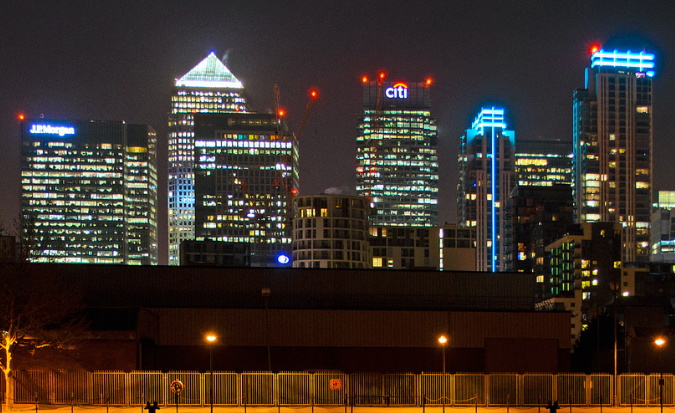This subject seems like a no-brainer at first. Put a couple of red lights on top of your building if it’s near an airport and that should be the end of it. Unfortunately it often gets more complicated for a range of reasons – this article seeks to explain some of the nuances that a tall building developer should know about.
 Figure 1: Buildings with aviation lighting
Figure 1: Buildings with aviation lighting
Why is lighting necessary?
Aircraft occasionally fly into the ground and very occasionally fly into buildings and structures. Aeronautical Ground Lights (AGL) can help pilots see buildings sooner and hence reduce the risk of aircraft flying into them.
What sort of lights are there?
Lights are defined by their colour, intensity, beam pattern and whether they flash or not. Typical colours specified in the United Kingdom are red, white and infrared. Typical intensities are 25 Candela, 200 Candela and 2000 Candela. For comparison purposes the tail light of a car has an intensity of around 25 Candela. Medium intensity steady red lights concentrate their light horizontally – so little light spills upwards or downwards. Occasionally flashing high intensity white lights are installed – for example at Canary Wharf which is close to the approach for London City Airport.
How much do lights cost?
Expect list prices for a single good quality light to be in the region of £1,500. For installations with multiple lights (especially if they are flashing) you are likely to require additional control equipment.
What issues should developers be thinking about?
Developers are often concerned about environmental impact. These concerns relate to the overall visual impact of the development (particularly at night) and for residential developments there are also concerns about aeronautical lights adversely affecting amenity.
Developers can also be concerned about providing power supplies and access to aeronautical lights.
Where are lights usually mounted?
Lights are normally mounted on the top corners of a building. On irregular buildings and structures they are mounted at the highest practical point. On some buildings there is a requirement to fit intermediate lights at lower elevations.
How do I know if I need lights?
In practice this is determined by the height of the building, consultation with local airports and airbases, UK aeronautical rules and regulations and European aeronautical rules and regulations. Some general guidelines:
- Buildings that are over 150 metres high will need at least some AGL lighting
- Tall buildings within the immediate vicinity of an airport or airbase are likely to require lighting
- Tall buildings on high ground within 15km of an airport or airbase may require lighting
What other factors should be taken into account?
Other factors that may influence the requirement for lighting include:
- The extent to which the building will be lit anyway
- Lighting on other buildings in the vicinity
- Whether local airports have adopted European safeguarding rules
What rules and regulations are there?
United Kingdom rules and regulations are specified in the Air Navigation Order with further rules and guidance in Civil Aviation Authority publications. European rules are published by the European Aviation Safety Agency with international rules being published by ICAO (International Civil Aviation Organisation). UK military standards are published by the Military Aviation Authority (MAA).
What services does Pager Power offer?
Pager Power helps developers determine whether lighting is required and what type of lighting is required. This can be determined from custom safeguarding and lighting assessments for specific airbases and airports. Pager Power can also engage with aviation stakeholders to agree lighting requirements for your building development.
“Reflection on Wharf” by Nevalenx via Flickr / CC BY-SA 2.0 / Image cropped and resized from original
